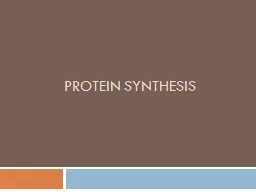

RNA RNA Protein Protein Scientists call this the Central Dogma of Biology Part 1 DNA Structure and Replication What is DNA DNA D eoxyribo n ucleic A cid It is the blueprint for life it is the molecule which stores genetic information in ALL living things ID: 929977
Download Presentation The PPT/PDF document "Protein Synthesis DNA DNA" is the property of its rightful owner. Permission is granted to download and print the materials on this web site for personal, non-commercial use only, and to display it on your personal computer provided you do not modify the materials and that you retain all copyright notices contained in the materials. By downloading content from our website, you accept the terms of this agreement.
Slide1
Protein Synthesis
Slide2DNA
DNA
RNA
RNA
Protein
Protein
Scientists call this the:
Central
Dogma
of
Biology!
Slide3Part 1: DNA Structure and Replication
Slide4What is DNA?
DNA =
D
eoxyribonucleic AcidIt is the blueprint for life – it is the molecule which stores genetic information in ALL living thingsDNA contains the instructions for making proteins, which control your cells
Slide5Nucleic Acids: DNA
DNA is a
nucleic acid
and is make up of two strands of nucleotidesA nucleotide is a monomer of a nucleic acid and has 3 parts connected with covalent bondssugarPhosphate group
Nitrogen BaseIn DNA, the sugar is deoxyribose
Slide6DNA
’
s Nitrogen Bases
There are four possible nitrogen bases2 are called purines (2 rings)AdenineGuanine
2 are called pyrimidines (1 ring)ThymineCytosineA purine always matches up with a pyrimidine this is called complementary base pairingAdenine pairs with thymine (A-T)Guanine pairs with cytosine (G-C)
Slide7DNA’s Shape
The nitrogen bases are held together in the middle by a weak
hydrogen bond
, which causes the ladder to twistThere are 3 between G and C and 2 between A and T.This causes the DNA to have a Double Helix shape
Slide8DNA Replication
Why does DNA need to replicate?
Before a cell can divide (through mitosis or meiosis) its genetic information must be copied for the new cell
This ensures that the new cell is genetically identical to the parent cell, and that it has all of the necessary information to carry on life processesThe structure of the double helix explains how DNA copies itself
Slide9DNA Replication
The
“
parent
”
molecule has two complementary strands of DNA.
Each is base paired by hydrogen bonding with its specific partner:A with T
G with C
Slide10DNA Replication
The first step in replication is the separation of the two strands. This is done by the enzyme
helicase
.
Helicase
unwinds the two strands and then breaks up the hydrogen bonds in the middle.
Slide11DNA Replication
Each exposed
parental strand now
serves as a template that determines the order of the bases along a new complementary strand
.
Free floating nucleotides in the nucleus will add on to each exposed strand, forming two new molecules of DNA.
This process is performed by
the enzyme
DNA polymerase. DNA polymerase adds the bases in the correct order, and also “proof-reads” the strands as it makes the new one.
A will pair with a T. T will pair with an A.
G will pair with a C. C will pair with a G.
Slide12DNA Replication
The nucleotides are connected to form the sugar-phosphate backbones of the new strands
. This is done by the enzyme
ligase
, which is like a “glue.”
Each
daughter
DNA molecule consists of one parental strand and one new strand.
This model of replication is called semi-conservative replication
. This is due to the fact that each new molecule has one old strand and one new strand. This ensures that each molecule of DNA is accurate.